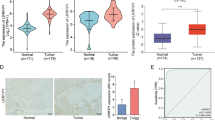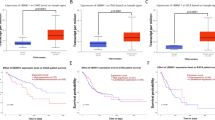Abstract
Although legumain has been found to be a prognostic factor in both breast cancer and colorectal cancer, its effects on gastric cancer are unknown. In this study, we investigated effects of legumain on gastric cancer and the correlation between legumain expression and prognosis of gastric cancer patients. SGC7901 cells were transduced with legumain cDNA (SGC7901-hLeg) for overexpression of legumain or with legumain shRNA to knock down legumain. In vitro tumor migration was examined by wound healing assay. Furthermore, a tumorigenicity and metastasis mouse model was used to examine legumain function in vivo; asparaginyl endopeptidase inhibitor (AEPI, an inhibitor of legumain) was injected to the mice (i.p.) to evaluate its therapeutic effect. Tissue microarray analysis from 112 gastric cancer patients was performed to evaluate the association between legumain expression and the cumulative survival time. Legumain was highly expressed in gastric cancer patients and some gastric cancer cell lines. Legumain promoted gastric cell migration in vitro and promoted gastric tumor growth and metastasis in vivo, and these effects were reversed by knockdown of legumain with shRNA or treated with AEPI. In gastric cancer clinical samples, legumain expression in tumor was significantly higher than in non-tumor and was negatively associated with the cumulative survival rate. In conclusion, legumain was highly expressed in gastric adenocarcinoma; legumain promoted gastric cancer tumorigenesis and metastasis in vitro and in vivo. Legumain expression in tumor was a poor prognostic factor for gastric cancer patients, and legumain could be a potential target molecule for gastric cancer therapy in clinic.





Similar content being viewed by others
References
Shah MA, Kelsen DP. Gastric cancer: a primer on the epidemiology and biology of the disease and an overview of the medical management of advanced disease. J Natl Compr Canc Netw. 2010;8:437–47.
Catalano V, Labianca R, Beretta GD, et al. Gastric Cancer. Crit Rev Oncol Hematol. 2005;54:209–41.
Siegel R, Naishadham D, Jemal A. Cancer statistics, 2012. 2012; 62(1):10–29.
Lim L, Michael M, Mann GB, et al. Adjuvant therapy in gastric cancer. J Clin Oncol. 2005;23:6220–32.
Chen JM, Dando PM, Rawlings ND, et al. Cloning, isolation, and characterization of mammalian legumain, an asparaginyl endopeptidase. J Biol Chem. 1997;272:8090–8.
Chen JM, Dando PM, Stevens RA, et al. Cloning and expression of mouse legumain, a lysosomal endopeptidase. Biochem J. 1998;335:111–7.
Shirahama-Noda K, Yamamoto A, Sugihara K, et al. Biosynthetic processing of cathepsins and lysosomal degradation are abolished in asparaginyl endopeptidase-deficient mice. J Biol Chem. 2003;278:33194–9.
Smith R, Johansen HT, Nilsen H, et al. Intra- and extracellular regulation of activity and processing of legumain by cystatin E/M. Biochimie. 2012;94:2590–9.
Morita Y, Araki H, Sugimoto T, et al. Legumain/asparaginyl endopeptidase controls extracellular matrix remodeling through the degradation of fibronectin in mouse renal proximal tubular cells. FEBS Lett. 2007;581:1417–24.
Chen JM, Fortunato M, Stevens RA, Barrett AJ. Activation of progelatinase A by mammalian legumain, a recently discovered cysteine proteinase. Biol Chem. 2001;382:777–83.
Liu C, Sun C, Huang H, et al. Overexpression of legumain in tumors is significant for invasion/metastasis and a candidate enzymatic target for prodrug therapy. Cancer Res. 2003;63:2957–64.
Murthy RV, Arbman G, Gao J, et al. Legumain expression in relation to clinicopathologic and biological variables in colorectal cancer. Clin Cancer Res. 2005;11:2293–9.
Gawenda J, Traub F, Lück HJ, et al. Legumain expression as a prognostic factor in breast cancer patients. Breast Cancer Res Treat. 2007;102:1–6.
Wang L, Chen S, Zhang M, et al. Legumain: a biomarker for diagnosis and prognosis of human ovarian cancer. J Cell Biochem. 2012;113:2679–86.
Wu W, Luo Y, Sun C, et al. Targeting cell-impermeable prodrug activation to tumor microenvironment eradicates multiple drug-resistant neoplasms. Cancer Res. 2006;66:970–80.
Luo Y, Zhou H, Krueger J, et al. Targeting tumor-associated macrophages as a novel strategy against breast cancer. J Clin Invest. 2006;116:2132–41.
Kessenbrock K, Plaks V, Werb Z. Matrix metalloproteinases: regulators of the tumor microenvironment. Cell. 2006;141:52–67.
Kubben FJ, Sier CF, van Duijn W, et al. Matrix metalloproteinase-2 is a consistent prognostic factor in gastric cancer. British J Cancer. 2006;94:1035–40.
Hsu FD, Nielsen TO, Alkushi A, et al. Tissue microarrays are an effective quality assurance tool for diagnostic immunohistochemistry. Mod Pathol. 2002;15:1374–80.
Yan F, Cao XX, Jiang HX, et al. A novel water-soluble gossypol derivative increases chemotherapeutic sensitivity and promotes growth inhibition in colon cancer. J Med Chem. 2010;53:5502–10.
Powers JC, James KE, Gotz MG, Caffrey CR, Hansell E, Carter W, et al. Aza-peptide epoxides: potent and selective inhibitors of Schistosoma mansoni and pig kidney legumains (Asparaginyl endopeptidases). Biol Chem. 2003;384(12):1613–8.
Wu BH, Yin J, Texier C, Roussel M. Blastocystis legumain is localized on the cell surface, and specific inhibition of its activity implicates a pro-survival role for the enzyme. J Biol Chem. 2010;285(3):1790–8.
Wang L, Heidt DG, Lee CJ, et al. Oncogenic function of ATDC in pancreatic cancer through Wnt pathway activation and b-catenin stabilization. Cancer Cell. 2009;15:207–19.
Whiteside TL. The tumor microenvironment and its role in promoting tumor growth. Oncogene. 2008;27:5904–12.
Acknowledgments
This work was supported by the National Natural Science Foundation of China (#30971137 and # 31171308) and Shanghai Commission for Science and Technology (11DZ1910200).
Conflict of interests
All authors indicated no potential conflicts of interests, and all authors could fully access the primary data and agree to allow the journal to review the data if requested.
Author information
Authors and Affiliations
Corresponding authors
Electronic supplementary material
Below is the link to the electronic supplementary material.
12032_2013_621_MOESM1_ESM.pdf
Supplemental figure 1. (A) Supernatants were collected and immunoblotted to detect the efficiency that stable transfection of legumain to SGC7901 cells, 56KD was prolegumain, while 36KD was active legumain. β-actin was used as an internal control for equal loading. (B) Wound healing assay was used to explore cell migration at 0 and 24 hour. The image demonstrated that, at 24 hour, cell migration was promoted in the legumain overexpression group compared to control group. (C) Number of migrated SGC7901 cells was much higher in legumain overexpressed cells than control cells. (D) MTS was used to detect SGC7901 cell proliferation at 24h, 48h, 72h. P value has no significance between control cells and legumain overexpressed SGC7901 cells. (E) Western blot assay was used to detect the efficiency that transient transfection of legumain to MKN45 cells, 56 KDa was prolegumain, while 36 KDa was active legumain. β-actin was used as an internal control for equal loading. (F) Wound healing assay show that overexpression of legumain promotes the migration of MKN45 cells. (G) Number of migrated cells in legumain overexpressed MKN45 cells were higher than control MKN45 cells, p = 0.0065. (H) AEPI-1 structure.
12032_2013_621_MOESM2_ESM.pdf
Supplemental figure 2. (A1, A2) MMP-2 negative in non-tumor tissues; magnifications were ×100, ×400, respectively. (B1, B2-D1, D2)) MMP-2 was highly expressed in tumor tissues; magnifications were ×100, ×400, respectively. (E) Number distribution of MMP-2 expression (low, medium, high) in non-tumor and tumor tissues. (F) MMP-2 expression between non-tumor and tumor tissues ( p< 0.0001). (PDF 368592 kb)
12032_2013_621_MOESM3_ESM.pdf
Supplemental figure 3. (A) Number distribution of legumain and MMP-2 coordinate expression. (B) Correlation between legumain expression and MMP-2 expression in tumor, r2 = 0.8640, p < 0.0001. (C) Kaplan-Meier curves used to analyze the association between MMP-2 expression in tumor and cumulative survival rate, p < 0.0001. (PDF 1892 kb)
Rights and permissions
About this article
Cite this article
Li, N., Liu, Q., Su, Q. et al. Effects of legumain as a potential prognostic factor on gastric cancers. Med Oncol 30, 621 (2013). https://doi.org/10.1007/s12032-013-0621-9
Received:
Accepted:
Published:
DOI: https://doi.org/10.1007/s12032-013-0621-9




